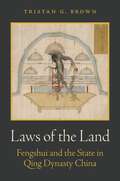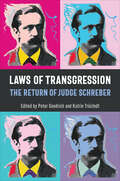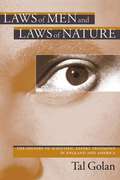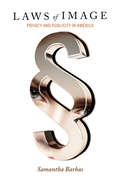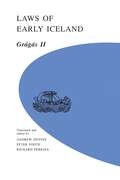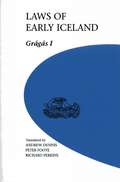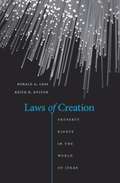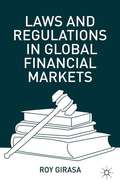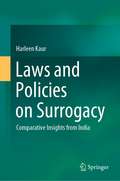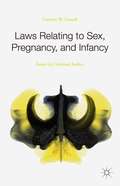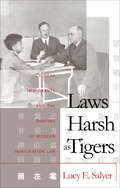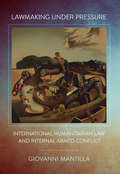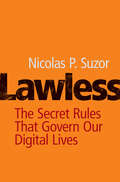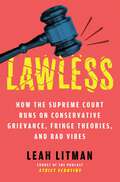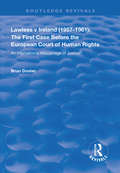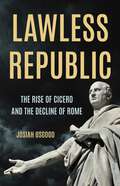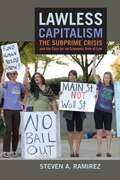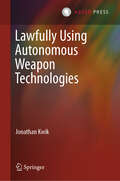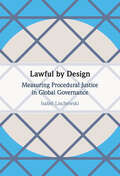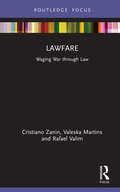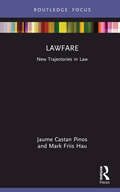- Table View
- List View
Laws of the Land: Fengshui and the State in Qing Dynasty China
by Tristan G. BrownA groundbreaking history of fengshui’s roles in public life and law during China’s last imperial dynastyToday the term fengshui, which literally means “wind and water,” is recognized around the world. Yet few know exactly what it means, let alone its fascinating history. In Laws of the Land, Tristan Brown tells the story of the important roles—especially legal ones—played by fengshui in Chinese society during China’s last imperial dynasty, the Manchu Qing (1644–1912).Employing archives from Mainland China and Taiwan that have only recently become available, this is the first book to document fengshui’s invocations in Chinese law during the Qing dynasty. Facing a growing population, dwindling natural resources, and an overburdened rural government, judicial administrators across China grappled with disputes and petitions about fengshui in their efforts to sustain forestry, farming, mining, and city planning. Laws of the Land offers a radically new interpretation of these legal arrangements: they worked. An intelligent, considered, and sustained engagement with fengshui on the ground helped the imperial state keep the peace and maintain its legitimacy, especially during the increasingly turbulent decades of the nineteenth century. As the century came to an end, contentious debates over industrialization swept across the bureaucracy, with fengshui invoked by officials and scholars opposed to the establishment of railways, telegraphs, and foreign-owned mines.Demonstrating that the only way to understand those debates and their profound stakes is to grasp fengshui’s longstanding roles in Chinese public life, Laws of the Land rethinks key issues in the history of Chinese law, politics, science, religion, and economics.
Laws of Transgression: The Return of Judge Schreber
by Peter Goodrich Katrin TrüstedtLaws of Transgression offers multiple perspectives on the story of Daniel Paul Schreber (1842–1911), a chamber president of the German Supreme Court who was institutionalized after claiming God had communicated with him, desiring to make him into a woman. Schreber was not only a successful judge, but was also to become the author of one of the most commented upon texts in psychiatric literature, Memoirs of My Nervous Illness. Published in 1903, this remarkable work documented Schreber’s visions, desires, jurisprudence, and theology. Far from ending the judge’s legal investments, it manifested an intensification of engagement with the law in the attempt to prove that becoming a woman did not deprive the judge of legal competence. Schreber’s experience of bodily change and his account of interior life has been the subject of more than a century of psychoanalytic and medical scrutiny. With the contemporary trans turn, interest in the judge’s desire to become a woman has intensified. In Laws of Transgression, Peter Goodrich, Katrin Trüstedt, and contributing authors set out to unfold Schreber’s complex relation to the law. The collection revisits and rediscovers the Memoirs, not only in its juridical and political implications, but as a transgressional text that has challenged law and heteronormativity.
Laws of Men and Laws of Nature: The History of Scientific Expert Testimony in England and America
by Tal GolanAre scientific expert witnesses partisans, or spokesmen for objective science? This ambiguity has troubled the relations between scientists and the legal system for more than 200 years. Modern expert testimony first appeared in the late eighteenth century, and while its use steadily increased throughout the nineteenth century, in cases involving everything from patents to X-rays, the respect paid to it steadily declined, inside and outside of the courtroom. With deep learning and wry humor, Tal Golan tells stories of courtroom drama and confusion and media jeering on both sides of the Atlantic, until the start of the twenty-first century, as the courts still search for ways that will allow them to distinguish between good and bad science.
Laws of Medicine: Core Legal Aspects for the Healthcare Professional
by Amirala S. PashaThis book provides an overview of the US laws that affect clinical practice for healthcare professionals with no legal background.Divided into thirteen sections, each chapter starts with a summary of the chapter’s content and relevant legal concepts in bullet points before discussing the topics in detail. An application section is provided in many chapters to clarify essential issues by reflecting on clinically relevant case law or clinical vignette(s). Filling a crucial gap in the literature, this comprehensive guide gives healthcare professionals an understanding or a starting point to legal aspects of healthcare.
Laws of Image: Privacy and Publicity in America
by Samantha BarbasAmericans have long been obsessed with their images--their looks, public personas, and the impressions they make. This preoccupation has left its mark on the law. The twentieth century saw the creation of laws that protect your right to control your public image, to defend your image, and to feel good about your image and public presentation of self. These include the legal actions against invasion of privacy, libel, and intentional infliction of emotional distress. With these laws came the phenomenon of "personal image litigation"--individuals suing to vindicate their image rights. Laws of Image tells the story of how Americans came to use the law to protect and manage their images, feelings, and reputations. In this social, cultural, and legal history, Samantha Barbas ties the development of personal image law to the self-consciousness and image-consciousness that has become endemic in our media-saturated culture of celebrity and consumerism, where people see their identities as intertwined with their public images. The laws of image are the expression of a people who have become so publicity-conscious and self-focused that they believe they have a right to control their images--to manage and spin them like actors, politicians, and rock stars.
Laws of Early Iceland: Gragas II (U of M Icelandic Series #4)
by Andrew Dennis Peter Foote Richard PerkinsThe laws of Mediaeval Iceland provide detailed and fascinating insight into the society that produced the Icelandic sagas. Known collectively as Gragas (Greygoose), this great legal code offers a wealth of information about early European legal systems and the society of the Middles Ages. This first translation of Gragas is in two volumes.
Laws of Early Iceland: Gragas I
by Andrew Dennis Peter Foote Richard PerkinsThe laws of Medieval Iceland provide detailed and fascinating insight into the society that produced the Icelandic sagas. Known collectively as Gragas (Greygoose), this great legal code offers a wealth of information about early European legal systems and the society of the Middles Ages. This first translation of Gragas is in two volumes.
Laws of Creation: Property Rights in the World of Ideas
by Ronald A. Cass Keith N. HyltonWhile innovative ideas and creative works increasingly drive economic success, the historic approach to encouraging innovation and creativity by granting property rights has come under attack by a growing number of legal theorists and technologists. In Laws of Creation, Ronald Cass and Keith Hylton take on these critics with a vigorous defense of intellectual property law. The authors look closely at the IP doctrines that have been developed over many years in patent, copyright, trademark, and trade secret law. In each area, legislatures and courts have weighed the benefits that come from preserving incentives to innovate against the costs of granting innovators a degree of control over specific markets. Over time, the authors show, a set of rules has emerged that supports wealth-creating innovation while generally avoiding overly expansive, growth-retarding licensing regimes. These rules are now under pressure from detractors who claim that changing technology undermines the case for intellectual property rights. But Cass and Hylton explain how technological advances only strengthen that case. In their view, the easier it becomes to copy innovations, the harder to detect copies and to stop copying, the greater the disincentive to invest time and money in inventions and creative works. The authors argue convincingly that intellectual property laws help create a society that is wealthier and inspires more innovation than those of alternative legal systems. Ignoring the social value of intellectual property rights and making what others create and nurture “free” would be a costly mistake indeed.
Laws in Conflict: A Mystery of Medieval Ireland (Burren Mysteries #8)
by Cora Harrison"Harrison, like Peter Tremayne in his Sister Fidelma series, provides a superior brand of historical mystery" Booklist. February, 1512. Mara, Brehon of the Burren, judge and lawgiver, has been invited to the magnificent city state of Galway, which is ruled by English laws and a royal charter originally granted by Richard III. Mara wonders whether she can use her legal knowledge to save the life of a man from the Burren who has been caught stealing a meat pie, but events soon take an even more dramatic turn when the mayor's son is charged with a heinous crime. Sure there is more to the case than meets the eye, Mara investigates ...
Laws and Regulations in Global Financial Markets
by Roy GirasaThe major financial scandals of the past decade, which have been discussed exhaustively in corporate offices by corporate attorneys, and in accounting firms, have led to the passage of massive Congressional enactments in the United States that impact the world of finance. The enactment of the Sarbanes-Oxley Act in 2002, with its significant provisions of 20-year imprisonment for certain offenses, and the conviction of Enron's CEO and other senior executives, finally caught the attention of corporate executives. Laws and Regulations in Global Financial Markets presents students, researchers, and practitioners with an in-depth global analysis of the legal and regulative aspects of corporate financial markets. Readers are introduced to international developments concerning rules and regulations impacting investment advisers and broker-dealers, bankruptcy law, important legal changes influencing banks and credit ratings organizations, real estate regulations, and insurance law. The book concludes with a discussion of personal finance, financial literacy, and federal statutes centered around the subject matter.
Laws and Policies on Surrogacy: Comparative Insights from India
by Harleen KaurThis book is an essential guide on surrogacy, discussing various legal issues that arise in surrogacy cases. It provides a comprehensive coverage to various issues pertaining to surrogacy arrangements due to failure to meet the needs of those involved in surrogacy, be it the intended parents or the surrogate mother, with special emphasis on the most vulnerable party -- the surrogate child. In the wake of this existing imbalance, the call to reform the practice of surrogacy has also increased. The book provides a comprehensive coverage to various laws and policy regulations in existence dealing with surrogacy, and unravels the latest trends and developments happening around the world as surrogacy gains importance. The international perspectives highlight policies and practices being adopted and followed by various nations with regard to surrogacy regulation and associated parenthood rules. This book also analyses some of the significant cross-border disputes revolving around surrogacy, and explores briefly the jurisprudence of the European Court of Human Rights on matters of parentage and citizenship for children born of trans-national surrogacy with special reference to the prospects of a convention on international surrogacy currently being studied by The Hague Conference on Private International Law. Further, it highlights the issues and questions relating to surrogacy arrangements that are so far unresolved and unanswered and suggests measures for improvements to the existing proposed surrogacy legislation in India and need for uniform international regulation. The book is a great resource for legal practitioners, academics, students, policy-makers, infertility clinics, and charitable organizations working on this issue.
Laws Relating to Sex, Pregnancy, and Infancy
by Carmen M. CusackLaws Relating to Sex, Pregnancy, and Infancy examines case law and legislation in regards to reproduction, pregnancy, and infancy. Cusack explores the winding pathways of legal precedence and action on the social conditions of pregnancy and childbirth, and draws from criminal and court procedures and behavioral science to determine if the law is acting in the best interest of those vulnerable populations. Cusack surveys interpersonal, familial, and societal problems presented throughout history and currently facing contemporary generations, questioning whether the criminal justice system can evolve to support the growing needs of its citizens most in need of legal assistance.
Laws Harsh As Tigers
by Lucy E. SalyerFocusing primarily on the exclusion of the Chinese, Lucy Salyer analyzes the popular and legal debates surrounding immigration law and its enforcement during the height of nativist sentiment in the early twentieth century. She argues that the struggles between Chinese immigrants, U.S. government officials, and the lower federal courts that took place around the turn of the century established fundamental principles that continue to dominate immigration law today and make it unique among branches of American law. By establishing the centrality of the Chinese to immigration policy, Salyer also integrates the history of Asian immigrants on the West Coast with that of European immigrants in the East.Salyer demonstrates that Chinese immigrants and Chinese Americans mounted sophisticated and often-successful legal challenges to the enforcement of exclusionary immigration policies. Ironically, their persistent litigation contributed to the development of legal doctrines that gave the Bureau of Immigration increasing power to counteract resistance. Indeed, by 1924, immigration law had begun to diverge from constitutional norms, and the Bureau of Immigration had emerged as an exceptionally powerful organization, free from many of the constraints imposed upon other government agencies.
Lawmaking under Pressure: International Humanitarian Law and Internal Armed Conflict
by Giovanni MantillaIn Lawmaking under Pressure, Giovanni Mantilla analyzes the origins and development of the international humanitarian treaty rules that now exist to regulate internal armed conflict. Until well into the twentieth century, states allowed atrocious violence as an acceptable product of internal conflict. Why have states created international laws to control internal armed conflict? Why did states compromise their national security by accepting these international humanitarian constraints? Why did they create these rules at improbable moments, as European empires cracked, freedom fighters emerged, and fears of communist rebellion spread? Mantilla explores the global politics and diplomatic dynamics that led to the creation of such laws in 1949 and in the 1970s.By the 1949 Diplomatic Conference that revised the Geneva Conventions, most countries supported legislation committing states and rebels to humane principles of wartime behavior and to the avoidance of abhorrent atrocities, including torture and the murder of non-combatants. However, for decades, states had long refused to codify similar regulations concerning violence within their own borders. Diplomatic conferences in Geneva twice channeled humanitarian attitudes alongside Cold War and decolonization politics, even compelling reluctant European empires Britain and France to accept them. Lawmaking under Pressure documents the tense politics behind the making of humanitarian laws that have become touchstones of the contemporary international normative order.Mantilla not only explains the pressures that resulted in constraints on national sovereignty but also uncovers the fascinating international politics of shame, status, and hypocrisy that helped to produce the humanitarian rules now governing internal conflict.
Lawless: The Secret Rules That Govern Our Digital Lives
by Nicolas P. SuzorRampant abuse, hate speech, censorship, bias, and disinformation - our Internet has problems. It is governed by technology companies - search engines, social media platforms, and infrastructure providers - whose hidden rules influence what we are allowed to see and say. In Lawless, Nicolas P. Suzor presents gripping examples of exactly how tech companies govern our digital environment and how they bend to pressure from governments and other powerful actors to censor and control the flow of information online. We are at a constitutional moment - an opportunity to rethink the basic rules of how the Internet is governed. Suzor offers a vision of a vibrant, diverse, and flourishing internet that can protect our fundamental rights from the lawless rule of tech. The culmination of more than ten years of original research, this groundbreaking work should be read by anyone who cares about the internet and the future of our shared social spaces.
Lawless: The Miseducation of America's Elites
by Ilya ShapiroIn the past, Columbia Law School produced leaders like Franklin Delano Roosevelt and Ruth Bader Ginsburg. Now it produces window-smashing activists.When protestors at Columbia broke into a building and created illegal encampments, the student-led Columbia Law Review demanded that finals be canceled because of “distress.”Law schools used to teach students how to think critically, advance logical arguments, and respect opponents. Now those students cannot tolerate disagreement and reject the validity of the law itself. Rioting Ivy Leaguers are the same people who will soon:Be America’s judges, DAs, and prosecutorsFile and fight constitutional lawsuitsAdvise Fortune 500 companiesHire other left-wing diversity candidates to staff law firms and government officesRun for higher office with an agenda of only enforcing laws that suit left-wing whimsIn Lawless, Ilya Shapiro explains how we got here and what we can do about it. The problem is bigger than radical students and biased faculty—it’s institutional weakness. Shapiro met the mob firsthand when he posted a controversial tweet that led to calls for his firing from Georgetown Law. A four-month investigation eventually cleared him on a technicality but declared that if he offended anyone in the future, he’d create a “hostile educational environment” and be subject to the inquisition again. Unable to do the job he was hired for, he resigned.This cannot continue. In Lawless, Shapiro reveals how the illiberal takeover of legal education is transforming our country. Unless we stop it now, the consequences will be with us for decades.
Lawless: How the Supreme Court Runs on Conservative Grievance, Fringe Theories, and Bad Vibes
by Leah LitmanSomething is deeply rotten at the Supreme Court. How did we get here and what can we do about it? <P> Crooked Media podcast host Leah Litman shines a light on the unabashed lawlessness embraced by conservative Supreme Court justices and shows us how to fight back. With the gravitas of Joan Biskupic and the irreverence of Elie Mystal, Leah Litman brings her signature wit to the question of what’s gone wrong at One First Street. In Lawless, she argues that the Supreme Court is no longer practicing law; it’s running on vibes. By vibes,” Litman means legal-ish claims that repackage the politics of conservative grievance and dress them up in robes. Major decisions adopt the language and posture of the law, while in fact displaying a commitment to protecting a single minority: the religious conservatives and Republican officials whose views are no longer shared by a majority of the country. <P> Dahlia Lithwick’s Lady Justice meets Rebecca Traister’s Good and Mad as Litman employs pop culture references and the latest decisions to deliver a funny, zeitgeisty, pulls-no-punches cri de coeur undergirded by impeccable scholarship. She gives us the tools we need to understand the law, the dynamics of courts, and the stakes of this current moment—even as she makes us chuckle on every page and emerge empowered to fight for a better future. <b>New York Times Bestseller</b>
Lawless: A Lawyer's Unrelenting Fight for Justice in a War Zone
by Kimberley MotleyIn the summer of 2008 Kimberley Motley quit her job as a public defender in Milwaukee to join a program that helped train lawyers in war-torn Afghanistan. She was 32 at the time, a mother of three who had never traveled outside the U.S. What she brought to Afghanistan was a toughness and resilience which came from growing up in one of the most dangerous cities in the country, a fundamental belief in everyone's right to justice, and an unconventional legal mind that has made her a legend in an archaic, misogynistic, and deeply conservative environment. Through sheer force of personality, ingenuity and perseverance, Kimberley became the first foreign lawyer to practice in Afghanistan and her work swiftly morphed into a mission—to bring "justness" to the defenseless and voiceless. She has established herself as an expert on its fledgling criminal justice system, able to pivot between the country's complex legislation and its religious laws in defense of her clients. Her radical approach has seen her successfully represent both Afghans and Westerners, overturning sentences for men and women who've been subject to often appalling miscarriages of justice. Inspiring and fascinating in equal measure, Lawless tells the story of a remarkable woman operating in one of the most dangerous countries in the world.
Lawless v Ireland: An International Miscarriage of Justice? (Routledge Revivals)
by Brian DoolanThis title was first published in 2001. The case of Lawless v Ireland is a landmark in the development of human rights jurisprudence. Stemming from the introduction of detention without trial by the Irish government in response to the resurgence of political violence, much of the material relevant to the case brought before the European Court of Human Rights, has remained closed to public scrutiny. This book is the first to provide a detailed documentary of the case, assessing the adequacy of the investigatory processes provided under the European Convention and questioning whether the factual conclusions reached by the European Commission on Human Rights were correct. In what will be an essential reference for academics and students of human rights, the book raises doubts as to whether the Strasbourg institutions, established to rectify national breaches of human rights, might in fact have perpetrated an international miscarriage of justice.
Lawless Republic: The Rise of Cicero and the Decline of Rome
by Josiah OsgoodA historian of Rome &“at the height of his powers&” (Barry Strauss, author of The War That Made the Roman Empire) narrates the erosion of law and order in the last years of the Roman Republic through the rise and fall of its most famous lawyer, Cicero In its final decades, the Roman Republic was engulfed by a crime wave. An epidemic of extortions, murders, and acts of insurrection tested the court system&’s capacity to maintain order. As case after case filled the docket, an ambitious young lawyer named Cicero seized every opportunity to litigate, forging a reputation as a master debater with a bright future in politics. In Lawless Republic, historian Josiah Osgood recounts the legendary orator&’s ascent and fall, and his pivotal role in the republic&’s lurch toward autocracy. Cicero&’s first appearance in the courts came shortly after the end of a brutal civil war. After leveraging his fame as a lawyer to become a consul, he ruthlessly crushed a coup by suppressing the liberties of Roman citizens. The premiere legal mind of Rome came to argue that the pursuit of a higher justice could sometimes justify sweeping the law aside, laying the groundwork for Roman history&’s most famous act of political violence—the assassination of Julius Caesar. Lawless Republic vividly resurrects the spectacle of the courts in the time of Cicero and Caesar, showing how politics trumped the rule of law and sealed the fate of Rome.
Lawless Capitalism: The Subprime Crisis and the Case for an Economic Rule of Law
by Steven A. RamirezInthis innovative and exhaustive study, Steven A. Ramirez posits that thesubprime mortgage crisis, as well as the global macroeconomic catastrophe itspawned, is traceable to a gross failure of law.Therule of law must appropriately channel and constrain the exercise of economicand political power. Used effectively, it ensures that economic opportunityisn’t limited to a small group of elites that enjoy growth at the expense ofmany, particularly those in vulnerable economic situations. In Lawless Capitalism, Ramirez calls forthe rule of law to displace cronycapitalism. Only through the rule of law, he argues, can capitalism bereconstructed.
Lawfully Using Autonomous Weapon Technologies
by Jonathan KwikThis monograph provides a practical and operational perspective to the question of how to lawfully employ autonomous weapon systems (AWS) from the point-of-view of the technology's end-users: field commanders. While there is international consensus that targeting rules such as proportionality and precautions must be respected when using AWS, there is legal and practical ambiguity as to how to translate this normative commitment into practice. How are commanders in the field, when guns are already blazing, expected to exercise command-and-control when ordering AWS-attacks, and ensure that their targeting obligations remain fulfilled? The book discusses how commanders can use existing targeting frameworks to ensure that their use of AWS remains in compliance with the rules governing the conduct of hostilities. It invites the reader to step into the shoes of the military commander with all the operational pressure and uncertainty inherent to this position, and explores amongst others: - How to maintain control of AWS throughout a targeting cycle; - How to make informed and reasoned deployment decisions by analysing information related to the technical parameters of the AWS, the characteristics of the operational environment, and enemy countermeasures; - Under which circumstances AWS may not be used under targeting rules, such as indiscriminate attack, proportionality and the duty to cancel/suspend; - What extra precautionary measures unique to AWS technology can and should be employed; - When it is militarily desirable to employ AWS over other alternatives; and - Under what circumstances criminal liability may be attributed for AWS-related harm. It offers both academic and practical outputs: new legal and doctrinal insights on the technology that is useful for future legal developments, and workable recommendations and efficient flowcharts that can be adopted by commanders, military organisations or policymakers to ensure IHL-compliant deployment of AWS. Dr. Jonathan Kwik is a researcher at the T.M.C. Asser Institute in The Hague specialised in artificial intelligence and targeting law, and is a member of the Board of Experts of the Asia-Pacific Journal of International Humanitarian Law.
Lawful by Design: Measuring Procedural Justice in Global Governance
by Isabel LischewskiIn recent years, the procedural rules of global governance institutions have come under scrutiny from scholars worldwide and have been conceptualized as akin to domestic administrative law. However, one question has so far not been addressed: who shapes this procedure and why? In the present work, Isabel Lischewski develops a simple matrix connecting procedure and state interest. When this matrix is applied to a sample of forty diverse institutions, fascinating patterns emerge, which are further explored through in-depth case studies. It is shown that states prefer to balance sovereignty preservation through procedure with the costs it entails. Thus, normative considerations are not the predominant basis on which this procedure is designed. The research provides original insights into the landscape of global governance procedure and cautions against a notion of “apolitical” administration law.
Lawfare: Waging War through Law
by Cristiano Zanin Martins Valeska Teixeira Martins Rafael ValimThis book examines one of the most emblematic cases of lawfare today: the criminal prosecution of former Brazilian President Lula. The authors argue that lawfare is not just a slogan or a game at the service of any one political ideology. Rather, it has to do with a complex, multifaceted phenomenon that should be carefully reflected upon in modern constitutional democracies, given that it is able to demolish majority rule and the rule of law. They contend it is the strategic use of the law with the purpose of delegitimizing, harming or annihilating an enemy. The literature specializing in the subject tends to alternate between analysis of only one aspect of the phenomenon or consists of extensive case studies. In order to fill this gap, this book revisits the subject and offers a sophisticated theoretical approach to lawfare, in an unprecedented combination of theory of war and theory of law. The book will be of interest to students, researchers and policy makers working in the areas of public law, international law, procedural law, anthropology of law and sociology of law, as well as political science and international relations.
Lawfare: New Trajectories in Law (New Trajectories in Law)
by Jaume Castan Pinos Mark Friis HauThis book develops a new conceptualisation of lawfare that recognises the polysemantic nature of the term. Drawing on theoretical developments from legal anthropology, international relations, and social theory, the book scrutinises the multiple dimensions of this phenomenon. It illustrates the multifaceted character of lawfare with a wide range of historical and contemporary cases from across the globe and analyses the implications of actors pursuing political objectives through legal means. This includes the use of lawfare by states as a legal instrument to accomplish geopolitical objectives, domestic lawfare, or the use of legal instruments to undermine internal opposition, and state lawfare used by governments to ‘protect’ the state from internal territorial-secessionist challenges. Finally, the book shows that lawfare is not exclusively a tool for hegemonic actors, as it can also be used by civil society actors that aim to uphold their rights through legal instruments in asymmetric lawfare. This book contributes to new developments in lawfare without shying away from controversy, acknowledging its sometimes-brutal efficacy as well as its potential pitfalls. The book will appeal to scholars and students of law, international relations, political science, anthropology, and sociology.
